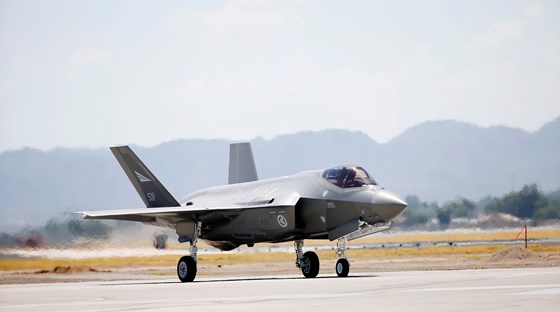Faulty Cooling Lines Identified on Two Norwegian F-35s
Historical archive
Published under: Solberg's Government
Publisher: Ministry of Defence
News story | Date: 16/09/2016
This summer Norway received its third and fourth F-35 at the Partner Training Center at Luke Air Force Base where they participate in the training of Norwegian and partner nation pilots. Several faulty cooling lines have now been identified in the wings of those two aircraft, leading to a decision by Norwegian authorities to temporarily suspend flight operations with these aircraft pending corrective measures.

- We have been very pleased with our aircraft so far, both in terms of performance and technical capabilities. This is not a design flaw, but is instead caused by a supplier using improper materials and improper sealing techniques for these specific parts. I expect Lockheed Martin to identify the appropriate measures to correct this issue, and that they implement these as quickly as possible, says Major General Morten Klever, the director of the Norwegian F-35 Program Office.
Like several other aircraft the F-35 uses its fuel tanks as part of its on-board cooling system, which means that several cooling lines have been installed inside the tanks to allow cooling liquid for the aircraft’s avionics and other systems to pass through. The lines are covered in insulating materials that in some cases have been found to decompose, leaving residue in the fuel. The issue has been traced back to cooling lines manufactured by one particular provider that have only been installed in the wing fuel tanks of 15 aircraft – 13 US and 2 Norwegian. Additionally, 42 aircraft currently on the production line have received parts from the same provider, including the three Norwegian aircraft scheduled for delivery early next year. Wing production has also commenced for the eighth Norwegian aircraft, but that has not been fitted with the faulty cooling lines, and is therefore not affected.
- This appears to have been an isolated incident. We expect this to be resolved by the time we receive the next aircraft currently in production. The F-35 will be key to our ability to defend Norway over the coming decades, and consequently we have imposed very strict requirements on the aircraft, says Major General Klever.
The insulation issue was discovered during routine depot maintenance of a US aircraft, with subsequent inspections confirming issues with other aircraft fitted with cooling lines from the same provider.
- What is positive in this is that this shows that the maintenance routines in place for the aircraft have worked. Along with the Joint Program Office we are working closely with Lockheed Martin to return the aircraft to flight status as quickly as possible. For now, our pilots at Luke Air Force Base can continue their training using other aircraft at the base, including the other two Norwegian jets. That in itself is proof of how international partnerships provide better solutions than if we had faced this issue on our own, says Major General Klever.
Norway plans to procure up to 52 F-35A, and has so far received four aircraft. Beginning in 2017, Norway plans to receive six aircraft annually, and the F-35 will begin taking over missions from the current F-16-fleet in 2019. As of September 2016 more than 200 F-35s have been delivered, including test aircraft, which have completed more than 68 000 flight hours, including roughly four hundred hours with Norwegian F-35s.
- Norway’s current fleet of F-16s is old, and we depend on them being replaced as planned to allow us to maintain our national readiness. We will therefore do all that we can to avoid this issue affecting our program more than what is absolutely necessary. It is vital to Norway that we continue to receive new aircraft at the right time, at the right price and with right quality, says Major General Klever.
For press enquiries please contact Communications Advisor within the Norwegian F-35 Program Office, Mr. Endre Lunde, on endre.lunde@fd.dep.no